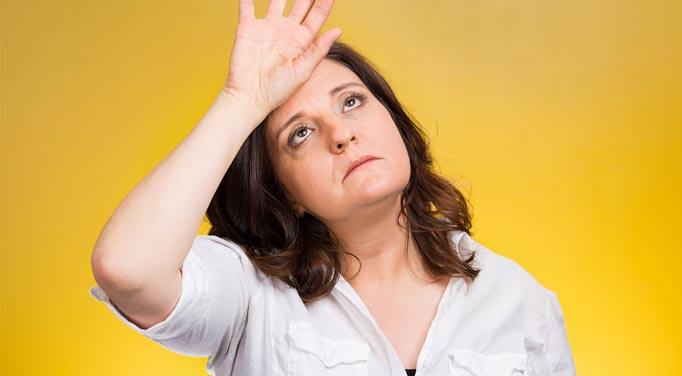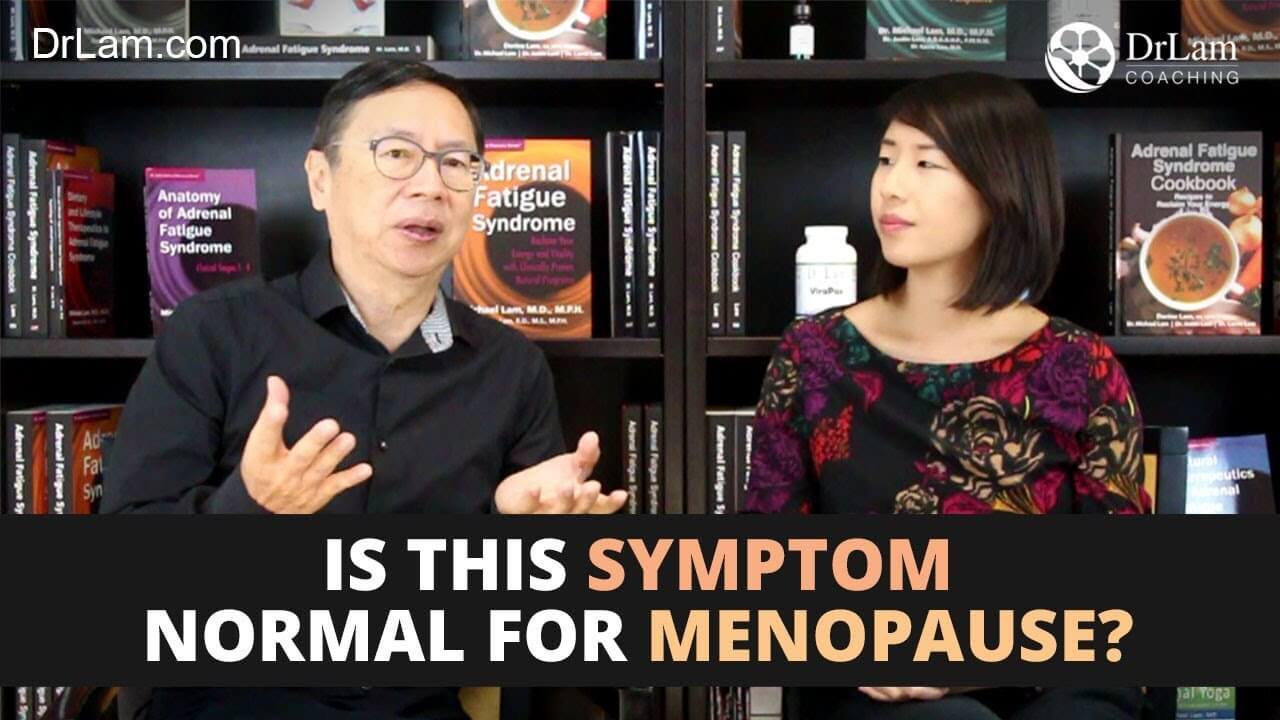
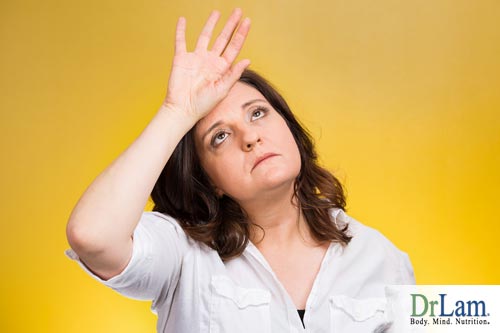 The onset of menopause signals the ending of a woman's reproductive cycle. Menopause actually begins after the women's last period. This event marks the culmination of several years of peri-menopausal changes during which hormones secreted by the ovaries (estrogen and progesterone) gradually decline. Peri- and menopausal symptoms vary considerably from person to person. Asians are known to have few to no symptoms other than irregular menses. Western women, however, have much higher incidences of body changes such as hot flashes, night sweats, reduced libido, forgetfulness, heart palpitations, loss of bladder control, frequent urination, and joint pains, to name a few. For some, these symptoms are like a "living hell." All women go through menopause. There is no escape for anyone from menopause and fatigue. What can you do to pass through this life stage in the most comfortable and protective manner?
The onset of menopause signals the ending of a woman's reproductive cycle. Menopause actually begins after the women's last period. This event marks the culmination of several years of peri-menopausal changes during which hormones secreted by the ovaries (estrogen and progesterone) gradually decline. Peri- and menopausal symptoms vary considerably from person to person. Asians are known to have few to no symptoms other than irregular menses. Western women, however, have much higher incidences of body changes such as hot flashes, night sweats, reduced libido, forgetfulness, heart palpitations, loss of bladder control, frequent urination, and joint pains, to name a few. For some, these symptoms are like a "living hell." All women go through menopause. There is no escape for anyone from menopause and fatigue. What can you do to pass through this life stage in the most comfortable and protective manner?
Once menopause arrives, the body's internal production of estrogen and progesterone stops. Women can no longer depend on their own body to produce these two hormones to protect themselves against osteoporosis and cardiovascular disease. The result to their health can be devastating.
Symptoms: fatigue, night sweats, mood swings, depression, hot flashes, sagging breast, vaginal dryness, osteoporosis, fibrocystic lumps, night sweats, painful intercourse, memory problems.
This hormone imbalance is most common in menopausal women; especially if you are petite and/or slim.
Solution: Progesterone is a biochemical precursor to estrogen. Progesterone cream alone is sufficient to restore estrogen balance and relief many of the symptoms. If after 3 months of progesterone cream, proper diet, nutritional supplementation of magnesium and B6 do not relive the symptoms, then low-dose natural estrogen may be considered. 2.5 mg of natural tri-estrogen cream (10% estrone, 10% estradiol, and 80% estriol) provides the equivalent action of 0.625 conjugated estrogen such as Premarin. Herbs like black cohash have weak estrogenic effect and may be considered as well.
Osteoporosis is the loss of bone density, leading to fractures. Post-menopausal women low in estrogen have a 25% chance of serious bone loss and fracture. The lifetime risk of hip fracture approaches 30% for those afflicted with osteoporosis, resulting in the loss of independent living. Many will die from their injuries.
Estrogen increases pliability of blood vessels, lowers "bad" LDL-cholesterol, increases "good" HDL-cholesterol, and decreases platelet aggregation that leads to blood clots. These protective properties of estrogen result in pre-menopausal women having a lower risk of heart disease than either men, or post-menopausal women. Post-menopausal women are just as vulnerable to heart disease as men of the same age. Cardiovascular disease is the leading cause of death in women over 45 years of age.
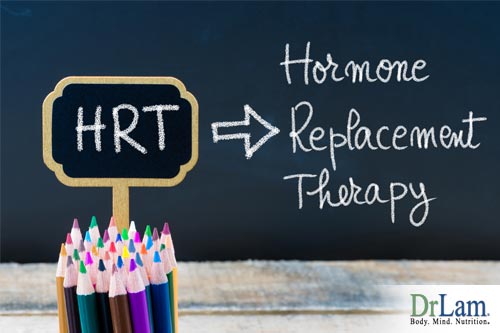 The solution for overcoming menopausal symptoms appears simple - Hormone Replacement Therapy (HRT). This has been a widely accepted practice for the past 40 years.
The solution for overcoming menopausal symptoms appears simple - Hormone Replacement Therapy (HRT). This has been a widely accepted practice for the past 40 years.
Studies and clinical experience have repeatedly shown that HRT using the widely prescribed estrogen Premarin® and progesterone Provera® does alleviate the symptoms of menopause and fatigue while protecting against heart disease and osteoporosis. The bad news is that they also increase the risk of some forms of cancer, including breast, ovarian, and uterine.
Simply put, the millions of women worldwide who have chosen to say "yes" to HRT in the past 40 years are gambling on feeling better immediately from menopause and fatigue, having an increased risk of cancer at age 60, a reduced risk of heart attack at 70, and a reduced chance of hip fracture at age 80.
What if you want HRT but not the associated increased risk of cancer that comes along with it? Are there other options?
Some doctors are proposing Natural treatment alternatives, using a different form of replacement hormone for menopause and fatigue. These doctors theorize that the increased cancer risk associated with conventional HRT arises from its failure to use the natural form of the hormones, estrogen and progesterone.
Specifically, these doctors postulate that the hormones currently used in HRT have mis-matched molecules. The commonly used estrogen preparation Premarin® is made from horse urine (equine based), so the molecular structure is slightly different from the natural form found in women's bodies. Furthermore, the hormones in Premarin® are "unbalanced" in that the ratio of the estrogen combination, estrone/estradial/estriol is different from the ratio found in humans.
How valid is this hypothesis? Let's take a closer look.
The two primary hormones secreted by the ovaries are estrogen and progesterone. The properties of one offset the other and together they are maintained in optimal opposing balance in our body at all times. Too much of one hormone or the other leads to significant medical problems.
Estrogen actually is not a single hormone but a trio of hormones working together. The three components of estrogen are: estrone, estradial, and estriol. In healthy young women, the typical mix approximates 15/70 percent respectively. This is the combination worked out by Mother Nature to be optimum for human females.
Out of the three components of estrogen, estrone and estradiol are pro-cancer, while estriol is anti-cancer. Synthetic estrogen such as Premarin® contains the pro-cancer components of estrogen (estrone and estradiol) in higher proportions compared to estriol.
Progesterone is made from pregnenolone, which in turn comes from cholesterol. Production occurs at several places. In the women, it is primarily made in the ovaries just before ovulation and increasing rapidly after ovulation. It is also made in the adrenal glands in both sexes and in the testes in males.
Its level is highest during the ovulation period (day 13-15 of the menstrual cycle). If fertilization does not take place, the secretion of progesterone decreases and menstruation occurs. If fertilization does occur, progesterone is secreted during pregnancy by the placenta and acts to prevent spontaneous abortion. About 20-25 mg of progesterone is produced per day during a woman's monthly cycle. 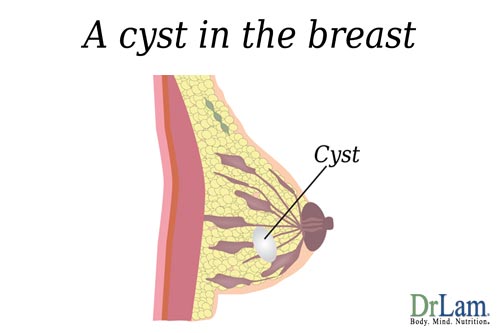 Up to 300-400 mg are produced daily during pregnancy. During menopause, the total amount of progesterone produced declined to less than 1% of the pre-menopausal level. This drop is extreme.
Up to 300-400 mg are produced daily during pregnancy. During menopause, the total amount of progesterone produced declined to less than 1% of the pre-menopausal level. This drop is extreme.
Functionally, progesterone acts as an antagonist (opposite to) to estrogen. For example, estrogen stimulates breast cysts while progesterone protects against breast cysts. Estrogen enhances salt and water retention while progesterone is a natural diuretic. Estrogen has been associated with breast and endometrial cancer, while progesterone has cancer preventive effect.
Most significantly, it is known that high amounts of estrogen can induce a host of metabolic disturbances, and the body's way of counterbalancing estrogen naturally is progesterone. When this balancing mechanism is dysfunctional, a multitude of health related problems arise.
Recall that the estrogen in our body is composed of a ratio of estrone, estradiol, and estriol of 15/70 (that is, heavy on estriol). We call this "natural estrogen" as it is the proportion Mother Nature intended it to be for humans. "Natural estrogens" are defined as those coming from natural sources with hormonal molecules identical to that found in the human body.
Commercial synthetic estrogen preparations such as Premarin® have a ratio of approximately 75/10 (heavy on estrone). We call this "unnatural estrogen." While it comes from a natural source (horse's urine), the ratio of the 3 components within this estrogen is more heavily estrone, and therefore is not similar to human estrogen. "Unnatural estrogens" in this case, come from sources other than plants with hormonal composition not 100% identical to that found in the human body.
When it comes to hormones, synthetic hormones (those made in a laboratory) may not work as well as the original, natural form. The body knows and can recognize the difference between many natural and synthetic compounds. Take Vitamin E as an example. After decades of study and debate, the National Academy of Science now acknowledges that natural Vitamin E is better absorbed and is twice as potent as the synthetic version.
Estrogen and Progesterone are both readily available in the natural and unnatural forms from the pharmacy. Conventional HRT does not use the natural forms of the hormones. The reason is simple. Any naturally occurring compound cannot be patented and drug companies control the prescription market. A slightly modified and patentable form of the hormone therefore has to be developed to ensure protection and commercial viability. Such synthetic "unnatural" modified forms of hormones developed by drug companies have been extremely profitable, but they are not exactly what the body is used to.
Two forms of synthetic (unnatural) estrogen are used in conventional HRT:
Estradiol. Consisting of only one of the components of natural estrogen, this unbalanced synthetic form of estrogen contains no estrone and no estriol. It increases your risk of cancer.
Premarin®. This consists of a combination of 75 - 80% estrone, 5 - 19% estradiol, and 6 - 15% equilin (a horse hormone), plus a trace amount of other horse hormones. Not only is this form unbalanced compared to the human body's natural estrogen ratio of 15/70%, the molecules of estriol which are derived from horse urine may be carcinogenic.
The common synthetic form of progesterone used in conventional HRT is called Provera, a synthetic progesterone which is called progestin.
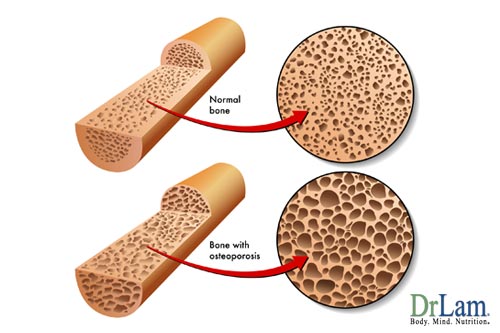 For your bones:
For your bones:
There is no doubt that the three-pronged approach to maintaining optimum bone health during menopause - HRT, nutritional supplementation with appropriate minerals, and weight-bearing exercises - decreases the risk of osteoporosis by preserving bone density.
Estrogen does not stimulate the growth of new bone but saves the bone already present in the body. Don't forget that estrogen takes 7 years to work. Meanwhile, progesterone (together with DHEA and testosterone) stimulates osteoblast formation. Osteoblasts are cells that lay down new bone. In other words, progesterone replacement heals weak bones, while estrogen merely prevents further bone deterioration. They work together. Any complete osteoporosis program should therefore incorporate both estrogen and progesterone replacement therapy if possible. Either one alone is also helpful in cases where, for medical reasons, the combination is not possible.
For your heart:
Premarin®, (an unnatural form of estrogen), does appear to reduce heart disease risk by almost half after women have taken it for several years, as seen in the long term study of more than 48,000 nurses. Unfortunately, the study also showed that Premarin® contributes to an increased risk for uterine cancer.
Premarin®, in combination with Provera® (an unnatural form of progesterone), eliminates the risk of cancer, but not the heart disease risk.
According to a large-scale study reported in the Journal of the American Medical Association, combining Premarin® with natural progesterone reduced heart disease risk to almost the same level as when Premarin® was taken alone. It can be deduced, therefore, that natural progesterone has cancer and cardiovascular protective effects when used in conjunction with Premarin®.
Unnatural estrogens such as Premarin® have been associated with increased risk of cancer of the breast, uterus (endometrial), and ovary. Women taking unnatural estrogen are at least four times more prone to developing endometrial cancer. They also have a 40% increased risk of developing ovarian cancer.
Researches at Harvard Medical School report that women who use unnatural estrogen for 5 years or more have a 30% higher chance of developing breast cancer compared to the control group.
Where is the Evidence?
Millions of American women have elected to be on conventional HRT based on the hundreds of studies and research done over the past 40 years. Unfortunately, the estrogen used in studies is not the natural form found in the human body. There is not even one well-controlled, large-scale study on the long-term use of natural estrogen as part of a HRT program for women.
We know that estrogen, whether natural or unnatural, helps relieve symptoms of menopause and fatigue, prevents heart disease, and slows the development of osteoporosis.
We also know that long-term use of unnatural estrogen causes cancer. And we have no proof that natural estrogen that is identical to that made by human bodies does not cause cancer.
So, those who elect to consider natural estrogen replacement therapy must proceed based on common sense. Recent interest in alternative and natural forms of HRT has spurred research on these forms, but it will take many years to complete.
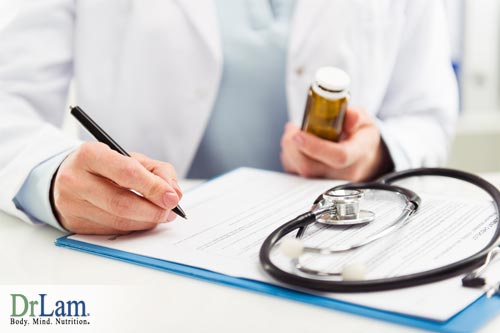 Dr. John Lee is a world-renowned authority on natural hormonal balance and author of the book Progesterone: The Multiple Roles of A Remarkable Hormone. He has treated thousands of women in suffering with menopause and fatigue in the 1980s and 1990s with a program that was contrary to popular medical thinking at that time. Instead of prescribing estrogen alone (the standard of medical practice then), Dr. Lee prescribes natural progesterone alone as treatment of menopausal symptoms. In addition to relief of menopausal symptoms, he was able to reverse osteoporosis and prevent cancer. Studies have confirmed Dr. Lee's approach, that progesterone alone has vast ranging palliative effects.
Dr. John Lee is a world-renowned authority on natural hormonal balance and author of the book Progesterone: The Multiple Roles of A Remarkable Hormone. He has treated thousands of women in suffering with menopause and fatigue in the 1980s and 1990s with a program that was contrary to popular medical thinking at that time. Instead of prescribing estrogen alone (the standard of medical practice then), Dr. Lee prescribes natural progesterone alone as treatment of menopausal symptoms. In addition to relief of menopausal symptoms, he was able to reverse osteoporosis and prevent cancer. Studies have confirmed Dr. Lee's approach, that progesterone alone has vast ranging palliative effects.
The key to Dr. Lee's approach is to understand the balance between estrogen and progesterone. In the pre-menopausal women, estrogen is always in balance with progesterone. When these two important hormones are out of balance, hormone related illnesses would emerge. Symptoms include weight gain, fatigue, auto-immune disorders, fibrocystic diseases, loss of libido, depression, headaches, joint pain and mood swings . These are just some of the common symptoms experienced during menopause, peri-menopause, and pre-menstrual time among those who have estrogen/progesterone imbalance.
According to Dr. Lee, what is commonly perceived as an absolute estrogen level deficiency during the menopausal years is in effect estrogen dominance in relative terms caused by extremely low progesterone level and thus unopposed estrogen dominance. Since progesterone's role is to balance estrogen, the extremely low level of progesterone experienced after menopause leads to a relative dominance of estrogen, despite a 50 percentage drop.
Dr. Lee treats menopause and fatigue as an estrogen dominance syndrome. His treatment is simple - reduce estrogen to progesterone ratio by increasing progesterone. When the opposing force of progesterone is increased, the toxic effect of estrogen is decreased. Fortunately for the many women who followed Dr. Lee's advice, their symptoms of menopause and fatigue improved remarkably.
The natural form of progesterone is quite different from the synthetic unnatural form made in a laboratory (the widely prescribed Provera®). The synthetic version is not really progesterone, but a compound called "progestin". Progestin is far more powerful than a woman's natural progesterone, and is metabolized as a foreign substance into toxic metabolites. These synthetic progesterones can severely interfere with the body's own natural progesterone, creating other hormone-related health problems, further exacerbating estrogen dominance, if the dosage is not adjusted properly. Side effects of synthetic progesterone include increased risk of cancer, abnormal menstrual flow, nausea, depression, masculinization, and fluid retention. It is usually used in small amounts to balance the estrogen effect in a HRT program.
Natural progesterone made from wild yams and soybeans is nearly identical to the progesterone a woman produces. This form of progesterone comes in micronized capsules or in creams. Creams are easily applied to the skin with the breast, thigh, and abdominal areas being the most common areas. The body easily converts these natural progesterones into the form identical to that found in the human body. Adverse side effects are very rare. If taken inappropriately, it might slightly alter the timing of the menstrual cycle. Please note that yam-derived natural progesterone should not be confused with "yam extracts" sold in health food stores. The effectiveness of "yam extracts" remains in doubt.
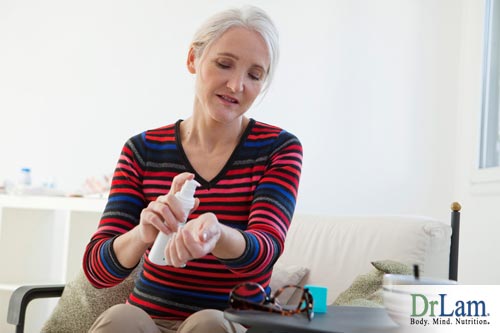 Direction: For those who are not on estrogen supplement: Choose a calendar day, such as the first day of the month. Apply 20 mg of natural progesterone (one full pump when properly dosed) of natural progesterone daily from day 1 to 25. Let the body rest the rest of the month. If a woman has not been making progesterone for a number of years, the body-fat progesterone is probably low. In this case, double up on the application for the first 2 months, and return to normal physiological dose thereafter.
Direction: For those who are not on estrogen supplement: Choose a calendar day, such as the first day of the month. Apply 20 mg of natural progesterone (one full pump when properly dosed) of natural progesterone daily from day 1 to 25. Let the body rest the rest of the month. If a woman has not been making progesterone for a number of years, the body-fat progesterone is probably low. In this case, double up on the application for the first 2 months, and return to normal physiological dose thereafter.
Direction: For those who are on estrogen supplement: reduce the dosage of estrogen supplement to half when starting the progesterone. If not, you will likely experience symptoms of estrogen dominance during the first one to two months of progesterone use. Every two to three months, reduce the estrogen supplement again by half again. Estrogen and progesterone can be used together during a three-week cycle each month, leaving a rest period of 7 days without either hormone. The estrogen dose should be low enough that monthly bleeding does not occur but high enough to prevent vaginal dryness or hot flashes.
Direction for those taking an estrogen and synthetic progesterone (such as Provera) combination: Stop the synthetic progesterone immediately when progesterone cream is added. Estrogen should be tapped off slowly.
Low dose natural estrogen (estriol) may be added for 3 weeks out of the month in cases of menopausal symptoms such as vaginal dryness and hot flashes unrelieved by progesterone cream alone.
Both men and women make testosterone. Testosterone is made by the adrenal glands, and the amount made by women is much less than the amount produced by men. A decline in testosterone levels in the body is associated with a decrease in sex drive and libido in both sexes. More than 50% of women past menopause report a decline in sexual desire. Testosterone replacement re-energizes the entire body, increases lean muscle mass, reversing the fat accumulation and muscular atrophy characteristic of aging.
For women, a small amount of testosterone, when added to the HRT, can work wonders to revive a sagging sex life. Note that other causes of decreasing sex drive (like depression) should be ruled out first.
Incidentally, for men, replacement and restoration of testosterone levels to the level of a 30 - 40 year old has a tremendous anti-aging effect. In addition to increasing libido, testosterone may protect men from heart disease. The normal blood level of testosterone ranges from 15 - 100 mg/dL in women and from 300 - 1,200 mg/dL in men. While there is no evidence that testosterone replacement causes cancer, men who do have cancer should not be on testosterone. Furthermore, complete laboratory testing is needed on a regular basis. Testosterone replacement may prove beneficial for women whose blood levels are below 65 and for men whose blood levels are below 800. Various forms (tablets, capsules, patches) are available in addition to injections.
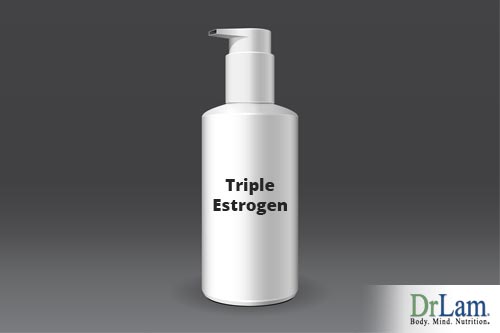 Natural estrogen mimics nature and can be formulated by any compounding pharmacy in accordance to the prescription by a physician. A popular combination commonly called "triple estrogen" consists of 10% estrone / 10% estradiol / 80% estriol. The usual oral starting dose is 2.5 mg per day. This is equivalent to 0.625 mg of Premarin®.
Natural estrogen mimics nature and can be formulated by any compounding pharmacy in accordance to the prescription by a physician. A popular combination commonly called "triple estrogen" consists of 10% estrone / 10% estradiol / 80% estriol. The usual oral starting dose is 2.5 mg per day. This is equivalent to 0.625 mg of Premarin®.
Since unopposed estrogen is unhealthy, micronized progesterone capsules (100 to 200 mg per day) or progesterone cream (½ to 1 teaspoon) daily should be considered together with estrogen.
The exact dosage varies from person to person. Both hormones need to be stopped for the first 7-10 days of the menstrual cycle or for one week each month if menstruation has stopped.
For those who are already on the unnatural form of estrogen, switching to the natural "triple estrogen" should be gradual. The transition should take place over a period of 3 months or more. Start with using the natural estrogen instead of unnatural estrogen and progesterone once every 3 days for the first month, increasing to once every 2 days for the second month, and so on.
Some may experience a transient resurgence of some symptoms of menopause and fatigue. This is a sign that the body is adjusting itself back to the normal form.
© Copyright 2013 Michael Lam, M.D. All Rights Reserved.
